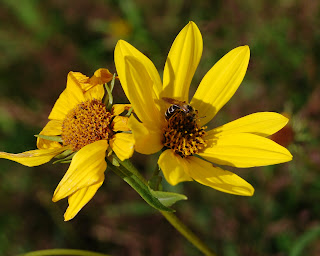Several hundred bees flew in figure-eight patterns in front of each bee hive this afternoon. The bees flew for several minutes in circling motions within three feet of the hive entrances. The activity looked somewhat like a bee colony swarming. Quietly, the flight activity returned to normal with foragers regularly flying in and out of the hives. Honey bees conduct “flight schools” in the afternoon for young bees to exercise their wings and learn the appearance and location of their hive entrance. These orientation flights of the young bees occur daily when the colony is producing young. The worker bees start flying before they become foragers at about three weeks of life. Prior to this time, the bees spend most of their time in the bee hive serving hive duties of cleaning the hive, feeding the brood, tending the queen, building honeycomb, transferring nectar, making honey, cooling the hive, removing dead bees, and guarding the hive. The presence of young bees in flight today is a welcomed sight; it means that the queen was producing brood in early October. These bees have a different physiology from spring and summer bees. They will live through the winter and have highly developed glands to produce food for next spring’s brood.
Honey bees also make orientation flights after a hive has been moved to a new location. The bees can be seen circling close to the hive entrance and then expanding their flight as they memorize visual landmarks. Beekeepers say that you can move a hive “two inches or two miles.” If a hive is moved a short distance, the foragers will return to the original site. Hives are usually moved several miles to prevent foragers from drifting back. However, for short hive moves, the bees can be encouraged to reorient by blocking the hive entrance with grass. Once the bees have chewed their way through a bundle of grass, they will start making orientation flights and memorize their new hive location.
--Richard















